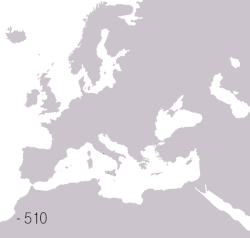**Founding and Early History of Rome:**
– Settlement around Rome emerges around 1000 BC
– Large-scale organization appears around 800 BC
– Romans start draining the valley between Capitoline and Palatine Hills around 650 BC
– Temple of Jupiter Optimus Maximus constructed by 6th century BC
– Romans attribute city’s founding to Romulus and Remus
– Evidence of kings in Rome in 6th century BC
– Rome controls territory of 780 square kilometers by end of 6th century BC
– Construction of Regia palace around 625 BC
– Romans extend control over Latin neighbors
– Shared culture among Latin cities by end of 6th century BC
**Roman Republic and Government:**
– Roman Republic established around 509 BC
– System based on annually elected magistrates and representative assemblies
– Constitution sets checks and balances with separation of powers
– Consuls hold executive authority and military command
– Republican voting assemblies include comitia centuriata and comitia tributa
**Roman Empire and Expansion:**
– Roman Empire spans from 27 BC to 395 AD
– State evolves from elective monarchy to autocratic dictatorship
– Controls North African coast, Egypt, Southern Europe, Western Europe, Balkans, Crimea, Middle East
– Grouped into classical antiquity with ancient Greece
– Contributions to modern language, religion, society, technology, law, politics, art, literature, and engineering
– Gauls defeated Romans at the Battle of the Allia in 390 BC
– Gauls looted Rome but were later defeated
– Romans subdued other peoples in Italy, including Etruscans
– Tarentum sought aid from Pyrrhus of Epirus in 281 BC, but failed
– Romans established control through founding colonies in strategic areas
**Julio-Claudian Dynasty and Successors:**
– The dynasty was established by Augustus and included emperors like Tiberius, Caligula, and Nero
– Augustus centralized power and diminished senatorial influence
– Augustus’ reign was marked by peace and military conquests
– Tiberius succeeded Augustus but was not enthusiastic about politics
– Caligula became emperor after Tiberius and was initially popular
– Claudius, chosen after Caligula’s assassination, conquered new territories
– Claudius was less authoritarian than his predecessors
**Crisis of the Third Century and Later Dynasties:**
– The crisis marked by political instability and economic chaos
– Military anarchy led to frequent changes in leadership
– The empire faced invasions by various tribes
– Emperors like Aurelian and Diocletian tried to stabilize the empire
– The crisis ended with the rise of the Tetrarchy
– Severan dynasty faced internal strife and military challenges
– The last Severan ruler was Alexander Severus
– After Alexander Severus’ death, the Roman Empire faced civil wars, invasions, and economic depression
– Emperors during this time rose from lower classes through military ranks
– There were 26 emperors in a 49-year period, indicating political instability
– The economy suffered from devaluation of coins and hyperinflation
In modern historiography, ancient Rome encompasses the founding of the Italian city of Rome in the 8th century BC, the Roman Kingdom (753–509 BC), Roman Republic (509–27 BC), Roman Empire (27 BC– 395 AD), and the collapse of the Western Roman Empire in the 5th century AD.
Roma | |
|---|---|
| 753 BC–476/480 AD | |
| Motto: Senatus Populusque Romanus | |
 Territories of the Roman civilisation:
| |
| Status | |
| Capital | Rome (and others during the late Empire, notably Constantinople and Ravenna) |
| Common languages | Latin |
| Government |
|
| Historical era | Ancient history |
| 753 BC | |
| 509 BC | |
• Octavian proclaimed Augustus | 27 BC |
| 476/480 AD | |
| |
Ancient Rome began as an Italic settlement, traditionally dated to 753 BC, beside the River Tiber in the Italian Peninsula. The settlement grew into the city and polity of Rome, and came to control its neighbours through a combination of treaties and military strength. It eventually controlled the Italian Peninsula, assimilated the Greek culture of southern Italy (Magna Grecia) and the Etruscan culture, becoming a dominant power in the Mediterranean region and parts of Europe. It was among the largest empires in the ancient world, with an estimated 50 to 90 million inhabitants, roughly 20% of the world's population at the time. It covered around 5 million square kilometres (1.9 million square miles) at its height in AD 117.
The Roman state evolved from an elective monarchy to a classical republic and then to an increasingly autocratic semi-elective military dictatorship during the Empire. Through conquest, cultural, and linguistic assimilation, at its height it controlled the North African coast, Egypt, Southern Europe, and most of Western Europe, the Balkans, Crimea, and much of the Middle East, including Anatolia, Levant, and parts of Mesopotamia and Arabia. It is often grouped into classical antiquity together with ancient Greece, and their similar cultures and societies are known as the Greco-Roman world.
Ancient Roman civilisation has contributed to modern language, religion, society, technology, law, politics, government, warfare, art, literature, architecture, and engineering. Rome professionalised and expanded its military and created a system of government called res publica, the inspiration for modern republics such as the United States and France. It achieved impressive technological and architectural feats, such as the empire-wide construction of aqueducts and roads, as well as more grandiose monuments and facilities.
